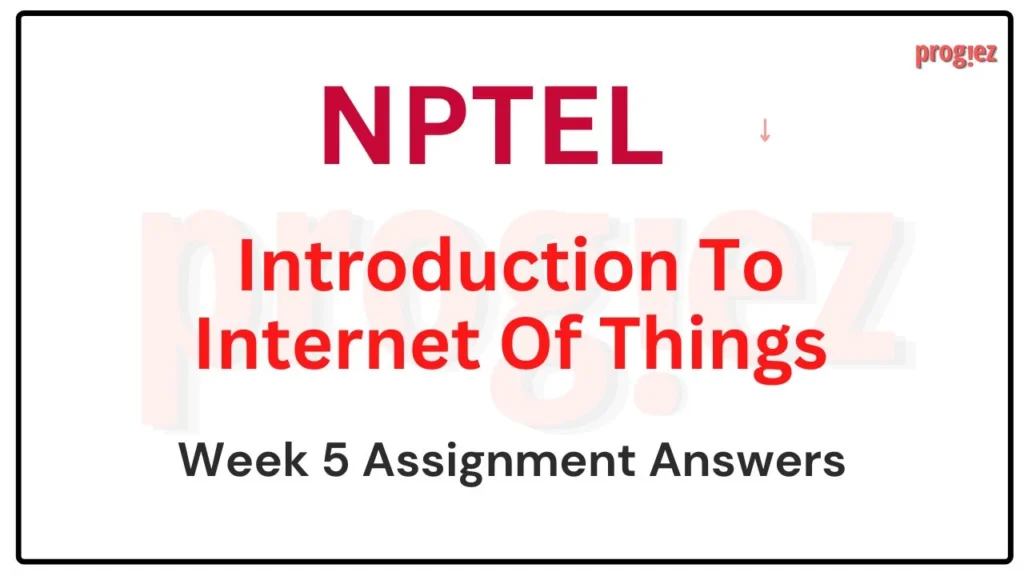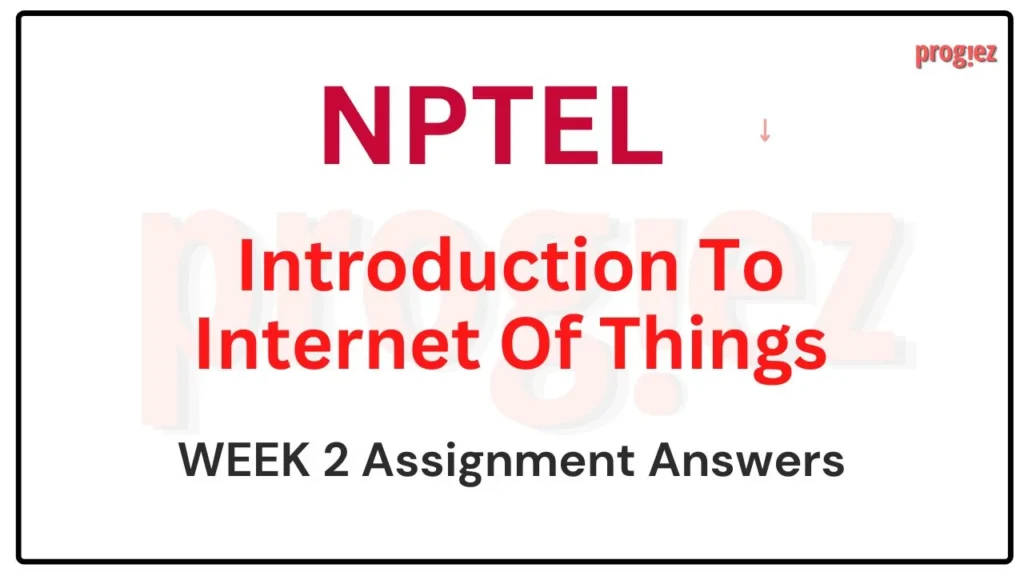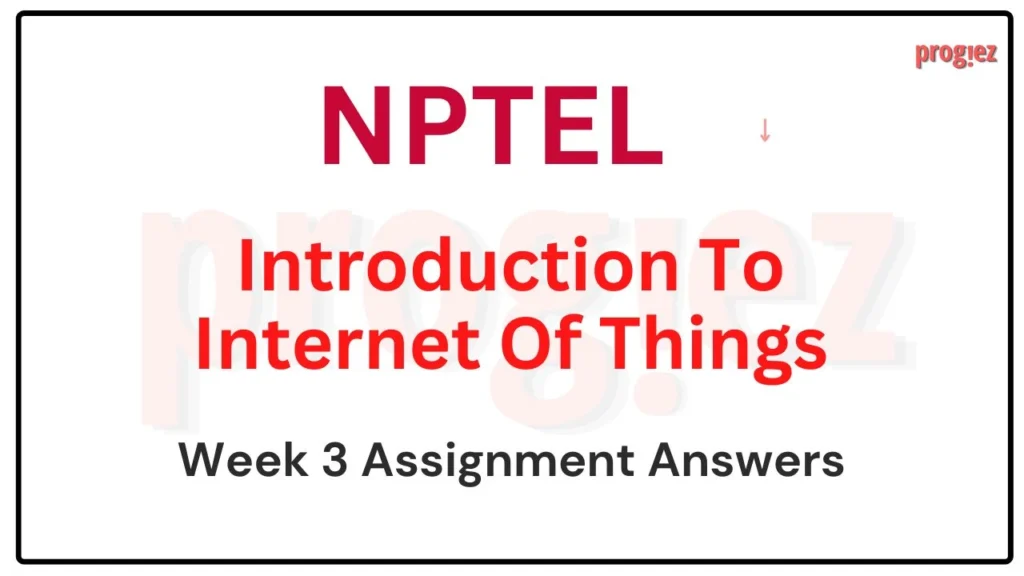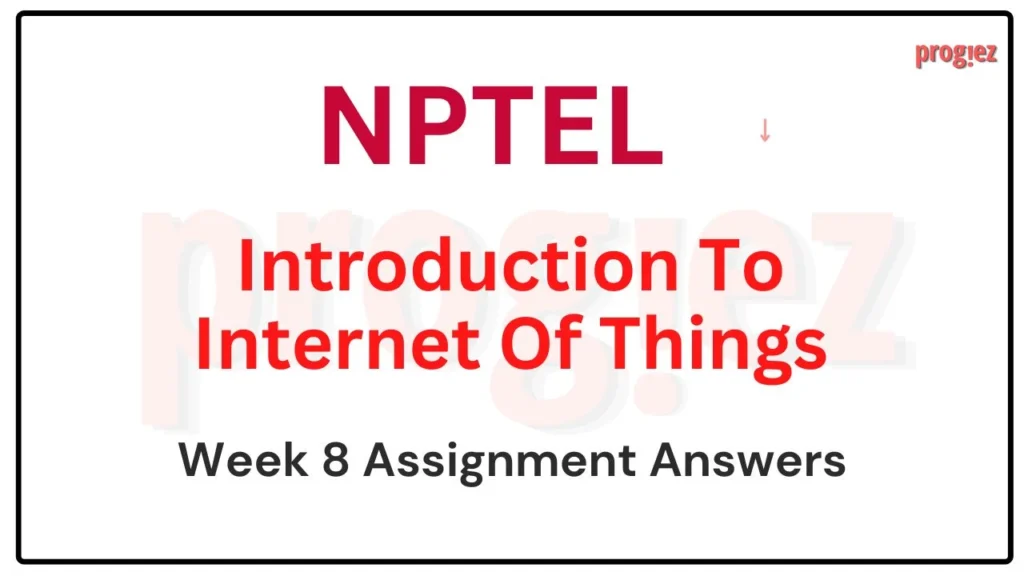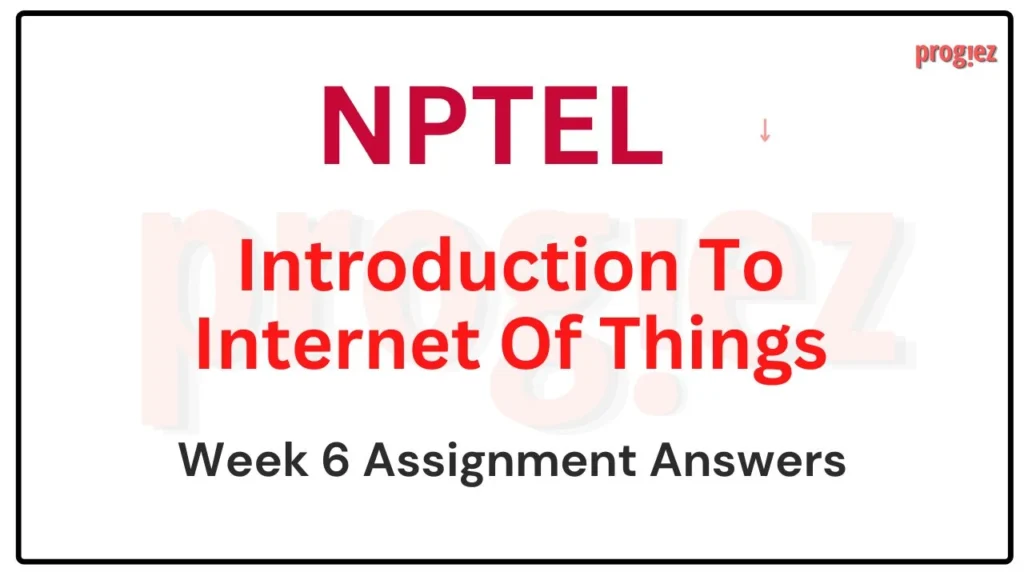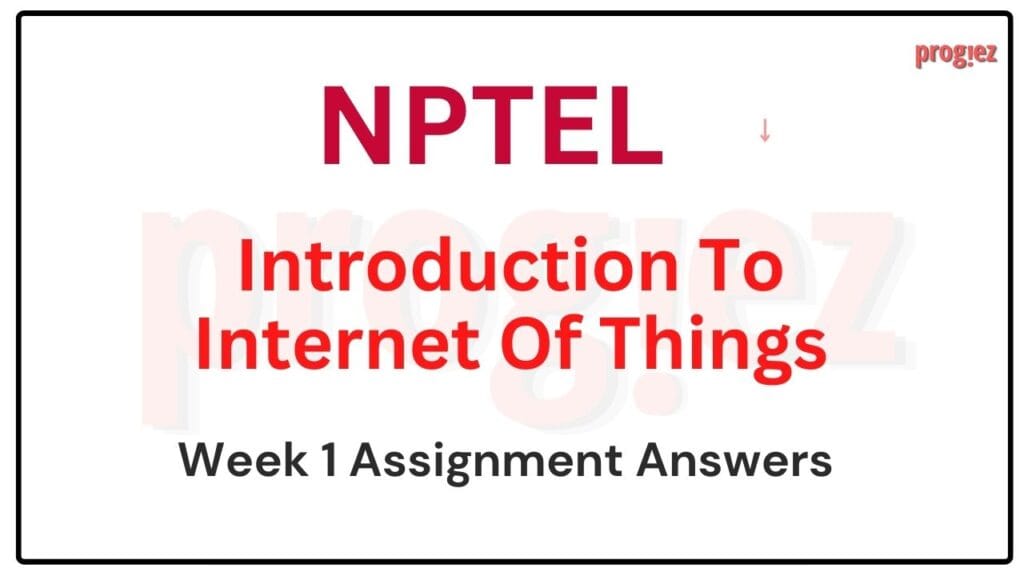Introduction To Internet Of Things Week 4 Nptel Answers
Are you searching for Introduction To Internet Of Things Week 4 Nptel Answers 2024? Look no further! Our comprehensive assignment solutions are designed to guide you through the key concepts of IoT, including networking protocols, sensor technologies, and data communication.
Table of Contents
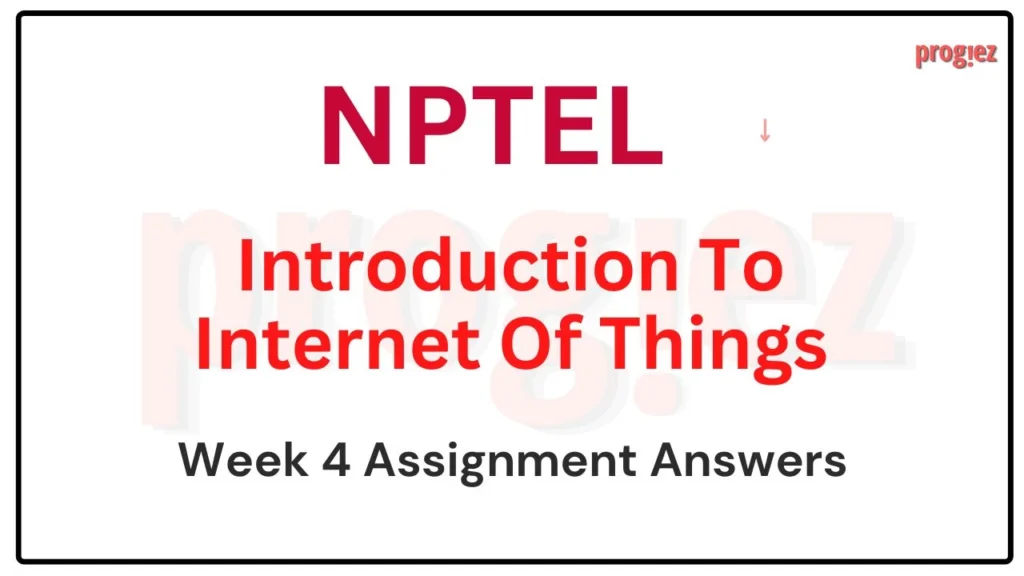
Introduction To Internet Of Things Week 4 Nptel Answers (Jan-Apr 2025)
Course Link: Click Here
Q1. In “AID,” a set of sensor nodes are deployed over an agricultural field.
a) True
b) False
Q2. Ultrasonic sensor senses the distance at which an object is located.
a) True
b) False
Q3. In case of static sensors, where to deploy and/or activate sensors in WSN is a coverage problem.
a) True
b) False
Q4. The objective of coverage in WSN is to use the maximum number of sensors and minimize network lifetime.
a) True
b) False
Q5. A crossing is covered if it is in the interior of at least one node’s coverage disk.
a) True
b) False
Q6. Which of the following is/are correct for stationary wireless sensor networks?
a) Topology cannot be changed automatically.
b) Node failure may result in partition of networks.
c) Both (a) and (b)
d) None of these
Q7. Most problems in static WSN can be classified as –
a) No coverage
b) More coverage
c) Both (a) and (b)
d) None of these
Q8. Which of the following is/are correct with respect to UAV networks?
a) Multi-tasking
b) Large coverage area
c) Both (a) and (b)
d) None of these
Q9. UAV networks are scalable.
a) True
b) False
Q10. In Mobile WSN, the Data Mules
a) Collect the data from sensor nodes
b) Go to the sink and deliver the collected data
c) Both (a) and (b)
d) Neither (a) nor (b)
Q11. The full form of AUV is –
a) Antenna Used Vehicle
b) Autonomous Underwater Vehicle
c) Both (a) and (b)
d) Neither (a) nor (b)
Q12. Humans carry their devices and move around. Sensors embedded within the devices record readings. Sensory readings are then transmitted for processing.
This paradigm of sensing is known as –
a) Machine Centric Sensing
b) Device Centric Sensing
c) Human Centric Sensing
d) None of these
Q13. Energy of Devices and Participant selection are not two major problems in Human Centric Sensing.
a) True
b) False
Q14. Which of the following network topologies is used in UAV networks?
a) Bus
b) Star
c) Both (a) and (b)
d) Neither (a) nor (b)
Q15. The M2M Application Platform provides integrated services based on device-collected data sets.
a) True
b) False
Check the answers at:
Introduction to IoT – NPTEL Answers
Introduction To Internet Of Things Week 4 Nptel Answers (July-Dec 2024)
Q1.State whether the following statement is true or false.
Statement: Coverage in WSN is defined as the entire area is covered satisfactorily.
a. True
b. False
Answer: b. False
Q2.State True or False.
Statement: “In Wireless Sensor Network coverage, we study how to deploy or activate sensors to cover the monitoring area.”
a. True
b. False
Answer: a. True
For answers or latest updates join our telegram channel: Click here to join
Q3.Water reservoir overflow monitoring in WSN is an example of which type of reporting?
a. Event driven
b. On-demand
с. Scattered
d. None of these
Answer: a. Event driven
Q4.State whether the following statement is true or false.
Statement: Objective of coverage in WSN is to use minimum number of sensors and minimize network lifetime.
a. True
b. False
Answer: b. False
For answers or latest updates join our telegram channel: Click here to join
Q5.State whether the following statement is true or false.
Statement: “Sensor nodes in WSN can be of two types 1. Static sensor nodes, and 2. Mobile sensor nodes.”
a. True
b. False
Answer: a. True
Q6,An inventory control system is an example of
a. Event-driven reporting
b. On-demand reporting
c. No sensing and reporting involvement
d. None of these
Answer: b. On-demand reporting
For answers or latest updates join our telegram channel: Click here to join
Q7.Most problems in static WSN can be classified as –
a. Area coverage
b. Barrier coverage
с. Both (a) and (b)
d. Neither (a) nor (b)
Answer : с. Both (a) and (b)
Q8.What are the disadvantages of Stationary WSN?
a. Node failure may result in the partition of networks
b. Topology cannot be changed automatically
c. Both (a) and (b)
d. Neither (a) nor (b)
Answer: c. Both (a) and (b)
For answers or latest updates join our telegram channel: Click here to join
Q9.State True or False.
Statement: “MANET-infrastructure less network of mobile devices connected wirelessly in WSN follow the self-HOP properties.”
a. True
b. False
Answer: b. False
Q10.In Mobile WSN, the Data Mules
a. Collect the data from sensor nodes
b. Goes to the sink and delivers the collected data
с. Both (a) and (b)
d. Neither (a) nor (b)
Answer: с. Both (a) and (b)
For answers or latest updates join our telegram channel: Click here to join
Q11………………………………senses different under the sea or water level parameters.
a. UAV
b. AUV
c. Both (a) and (b)
d. Neither (a) nor (b)
Answer: b. AUV
Q12.Humans carry their devices and move around. Sensors embedded within the devices record readings. Sensory readings are then transmitted for processing.
This paradigm of sensing is known as
a. Machine Centric Sensing
b. Device Centric Sensing
c. Human Centric Sensing
d. None of these
Answer:c. Human Centric Sensing
For answers or latest updates join our telegram channel: Click here to join
Q13 State True or False.
Statement: “Energy of Devices and Participant selection are two major problems in Human Centric Sensing.”
a. True
b. False
Answer: a. True
Q14.Which of the following network topologies is used in UAV networks?
a. Mesh
b. Star
c. Both (a) and (b)
d. Neither (a) nor (b)
Answer: c. Both (a) and (b)
For answers or latest updates join our telegram channel: Click here to join
These are Introduction To Internet Of Things Week 4 Nptel Answers
Q15.The ………………………..provides integrated services based on device collected data-sets.
a. M2M Application Platform
b. M2M Service Platform
c. M2M Hardware Platform
d. None of these
Answer: a. M2M Application Platform
For answers or latest updates join our telegram channel: Click here to join
More Weeks of Introduction To Internet Of Things: Click here
More Nptel Courses: https://progiez.com/nptel-assignment-answers
Introduction To Internet Of Things Week 4 Nptel Answers (JAN-APR 2024)
Course Name: Introduction To Internet Of Things
Course Link: Click Here
For answers or latest updates join our telegram channel: Click here to join
These are Introduction To Internet Of Things Week 4 Nptel Answers
Q1. State whether the following statement is true or false.
Statement: Coverage in WSN is defined as the area-of-interest that is covered satisfactorily.
a. True
b. False
Answer: a. True
Q2. If transmission range >= 2* sensing range,
a. Coverage implies connectivity
b. Coverage implies greater coverage
c. Both (a) and (b)
d. None of these
Answer: a. Coverage implies connectivity
Q3. Forest fire monitoring in WSN is an example of which type of reporting?
a. Event driven
b. On-demand
c. Scattered
d. None of these
Answer: a. Event driven
For answers or latest updates join our telegram channel: Click here to join
These are Introduction To Internet Of Things Week 4 Nptel Answers
Q4. State whether the following statement is true or false.
Statement: Objective of coverage in WSN is to use minimum number of sensors and maximize network lifetime.
a. True
b. False
Answer: a. True
Q5. What is the full form of AUV in the context of mobile wireless sensor networks?
a. Aerial and Underwater Vehicle
b. Ambient and Underprivileged Vehicle
c. Autonomous Underwater Vehicle
d. None of these
Answer: c. Autonomous Underwater Vehicle
Q6. In mobile wireless sensor networks, the sensor nodes are capable of ________ and measuring the condition of their surrounding environments.
a. collaborating with one another
b. destroying one another
c. Both (a) and (b)
d. None of these
Answer: a. collaborating with one another
For answers or latest updates join our telegram channel: Click here to join
These are Introduction To Internet Of Things Week 4 Nptel Answers
Q7. State whether the following statement is true or false.
Statement: In mobile sensor networks, the sensor nodes come in close proximity of sink and deliver the data.
a. True
b. False
Answer: a. True
Q8. Which of the following is/are a challenge/challenges in Human-centric Sensing?
a. Energy of devices
b. Participant selection
c. Both (a) and (b)
d. None of these
Answer: c. Both (a) and (b)
Q9. Which of the following is/are a feature/features of UAV networks?
a. Mesh or star networks
b. Multi-tasking
c. Large coverage area
d. All of these
Answer: d. All of these
For answers or latest updates join our telegram channel: Click here to join
These are Introduction To Internet Of Things Week 4 Nptel Answers
Q10. State whether the following statement is true or false.
Statement: Frequently change in network topology is a benefit of UAV networks.
a. False
b. True
Answer: a. False
Q11. Which of the following is NOT a feature of multi-UAV system?
a. Low failures
b. High scalability
c. Low survivability
d. High cost
Answer: c. Low survivability
Q12. State whether the following statement is true or false.
Statement: M2M communications are free of any human intervention.
a. True
b. False
Answer: a. True
For answers or latest updates join our telegram channel: Click here to join
These are Introduction To Internet Of Things Week 4 Nptel Answers
Q13. Which of the following is NOT an M2M node type?
a. Secure End Node
b. High End Node
c. Low End Mode
d. Mid End Node
Answer: a. Secure End Node
Q14. What is the full form of M2SP in the context of Machine-to-Machine Communication?
a. M2M Service Platform
b. M2M Session Packet
c. M2M Secure Packaging
d. None of these
Answer: a. M2M Service Platform
Q15. The _________ provides integrated services based on device collected data-sets.
a. M2M Application Platform
b. M2M Service Platform
c. M2M Hardware Platform
d. None of these
Answer: a. M2M Application Platform
For answers or latest updates join our telegram channel: Click here to join
These are Introduction To Internet Of Things Week 4 Nptel Answers
More Weeks of Introduction To Internet Of Things: Click here
More Nptel Courses: Click here
Introduction To Internet Of Things Week 4 Nptel Answers (JULY-DEC 2023)
Course Name: Introduction To Internet Of Things
Course Link: Click Here
These are Introduction To Internet Of Things Week 4 Nptel Answers
Q1. State whether the following statement is true or false.
Statement: Coverage in WSN is defined as the area-of-interest is covered satisfactorily.
a. True
b. False
Answer: a. True
Q2. If transmission range >= 2* sensing range,
a. Coverage implies greater coverage
b. Coverage implies connectivity
c. Both (a) and (b)
d. None of these
Answer: b. Coverage implies connectivity
Q3. The two types of reporting in WSN are –
a. Event driven and machine driven
b. Event driven and weather driven
c. Event driven and on demand
d. None of these
Answer: c. Event driven and on demand
These are Introduction To Internet Of Things Week 4 Nptel Answers
Q4. The objective of coverage in WSN is to use a ___ number of sensors and ___ the network lifetime.
a. minimum, minimize
b. minimum, maximize
c. maximum, minimize
d. maximum, maximize
Answer: b. minimum, maximize
Q5. Select the correct option.
The disadvantages of stationary Wireless Sensor Networks are –
Statement-I: Node failure may result in partition of networks.
Statement-II: Topology cannot change automatically.
a. Statement-I True, Statement-II False
b. Both Statements are False
c. Both Statements are True
d. None of these
Answer: c. Both Statements are True
Q6. A _____ in MWSN moves in order to collect data from sensor nodes and goes to the sink and delivers the collected data from different sensor nodes.
a. Drop
b. Molecule
c. Mule
d. None of these
Answer: c. Mule
These are Introduction To Internet Of Things Week 4 Nptel Answers
Q7. ____ allows distributed sensing carried by humans and the goal is not just to collect data but to allow the common people to assess and share the knowledge.
a. Voluntary sensing
b. Compressive sensing
c. Dynamic sensing
d. Participatory sensing
Answer: d. Participatory sensing
Q8. Which of the following is/are NOT feature/features of UAV networks?
a. Mesh or star networks
b. Multi-tasking
c. Large coverage area
d. None of these
Answer: d. None of these
Q9. Which of the following is NOT a UAV network constraint?
a. Frequent link breakages
b. Prone to malfunction
c. Very Complex
d. None of these
Answer: d. None of these
These are Introduction To Internet Of Things Week 4 Nptel Answers
Q10. In _________ configuration, UAVs form multiple star topology. One node from each group connects to the ground station.
a. Multi-star
b. Ring
c. Both (a) and (b)
d. None of these
Answer: a. Multi-star
Q11. The full form of FANET is?
a. Flying Ad Hoc Network
b. Fast Ad Hoc Network
c. Fidelity Ad Hoc Network
d. None of these
Answer: a. Flying Ad Hoc Network
Q12. Low-end sensor nodes are those-
a. Whose deployment has high density in order to increase network lifetime and survivability.
b. Who perform basic functions such as data aggregation, auto configuration, and power saving.
c. Both (a) and (b)
d. None of these
Answer: c. Both (a) and (b)
These are Introduction To Internet Of Things Week 4 Nptel Answers
Q13. Which of the following are the components of the M2M ecosystem?
a. Trees
b. Ocean
c. Device Providers
d. Non-service users
Answer: c. Device Providers
Q14. State whether the following statement is true or false
Statement: The M2M Device Platform enables access to objects connected to the Internet anywhere any time.
a. True
b. False
Answer: a. True
Q15. State whether the following statement is true or false
Statement: The M2M Application Platform provides integrated services based on device collected data-sets.
a. True
b. False
Answer: a. True
These are Introduction To Internet Of Things Week 4 Nptel Answers
More Weeks of Introduction To Internet Of Things: Click here
More Nptel Courses: Click here
Introduction To Internet Of Things Week 4 Nptel Answers (JAN-APR 2023)
Course Name: Introduction To Internet Of Things
Course Link: Click Here
These are Introduction To Internet Of Things Week 4 Nptel Answers
Q1. When an intruder enters into the agricultural field through the boundary (perimeter) of the field, a/an ________ sensor can be used to detect the object and a/an _________ sensor can be used to sense the distance at which the object is located.
a. PIR, Ultrasonic
b. Ultrasonic, PIR
c. Humidity, PIR
d. None of these
Answer: a. PIR, Ultrasonic
Q2. _________ is defined as, all the nodes are connected in the network, so that sensed data can reach to sink node?
a. Coverage
b. Connectivity
c. Both (a) and (b)
d. None of these
Answer: b. Connectivity
Q3. The objective of coverage in WSN is
a. To use a minimum number of sensors and maximize the network lifetime
b. To use a maximum number of sensors and maximize the network lifetime
c. To use a minimum number of sensors and minimize the network lifetime
d. To use a maximum number of sensors and minimize the network lifetime
Answer: a. To use a minimum number of sensors and maximize the network lifetime
These are Introduction To Internet Of Things Week 4 Nptel Answers
Q4. State True or False
Statement-I: If transmission range ≤ 2* sensing range, coverage implies connectivity.
a. Statement-I is True
b. Statement-I is False
Answer: b. Statement-I is False
Q5. A mobile entity that collects the data from sensor nodes goes to the sink, and delivers the collected data from different sensor nodes are called?
a. Data Molecule
b. Static Node
c. Data Mules
d. None of these
Answer: c. Data Mules
Q6. Human-centric Sensing is possible because of?
a. Smartphone and PDAs
b. Miniaturization and Proliferation of devices
c. Both (a) and (b)
d. None of these
Answer: c. Both (a) and (b)
These are Introduction To Internet Of Things Week 4 Nptel Answers
Q7. Which of the following are the roles played by humans in Human-centric Sensing?
a. Sensing Targets
b. Sensor Operators
c. Data Source
d. All of these
Answer: d. All of these
Q8. Which of the following is/are NOT goal of Participatory Sensing?
a. To only collect data
b. Not just collect data, but allow common people to access data and share knowledge
c. To only access data
d. Both (a) and (c)
Answer: d. Both (a) and (c)
Q9. The two popular network topologies in UAV networks are
a. Ring
b. Mesh and Star
c. Bus
d. All of these
Answer: b. Mesh and Star
These are Introduction To Internet Of Things Week 4 Nptel Answers
Q10. Which of the following is NOT an issue in UAV networks?
a. Slow change in network topology
b. Malfunctioning of UAVs
c. Intermittent link nature
d. Relative position of UAV may change
Answer: a. Slow change in network topology
Q11. The scalability in single UAV system as compared to multi-UAV system is?
a. Limited
b. High
c. Very High
d. None of these
Answer: a. Limited
Q12. Typical types of mesh networks in UAV networks are
a. Solid Mesh and Hierarchical Mesh
b. Plane Mesh and Solid Mesh
c. Flat Mesh and Hierarchical Mesh
d. None of these
Answer: c. Flat Mesh and Hierarchical Mesh
These are Introduction To Internet Of Things Week 4 Nptel Answers
Q13. State True or False
Statement-I: SCADA is designed for isolated systems using proprietary solutions, whereas M2M is designed for cross-platform integration.
a. False
b. True
Answer: b. True
Q14. Which of the following is NOT a feature of M2M?
a. Large number of nodes or devices
b. High cost
c. Energy efficient
d. Small traffic per machine/device
Answer: b. High cost
Q15. Which of the following is NOT an M2M node type?
a. Low End Node
b. High End Node
c. Out End Node
d. None of these
Answer: c. Out End Node
These are Introduction To Internet Of Things Week 4 Nptel Answers
All weeks of Introduction to Internet of Things: Click Here
More Nptel courses: Click Here
Introduction To Internet Of Things Week 4 Nptel Answers (Jul-Dec 2022)
These are Introduction To Internet Of Things Week 4 Nptel Answers
Course Name: Introduction To Internet Of Things
Link to Enroll: Click Here
Q1. Which of the following UAV topology is self-configuring?
a. Mesh
b. Star
c. Both mesh and star
d. Grid
Answer: c. Both mesh and star
Q2. In WMSNs application, which of the following deployment can provide better sensing and prolong network lifetime?
a. Scalar sensor nodes
b. Camera sensor nodes
c. Both scalar and camera sensor nodes
d. Vector sensor nodes
Answer: c. Both scalar and camera sensor nodes
Q3. In which of the following algorithms only a subset of nodes in the WASN participate in sensing, communication, and computation?
a. Localized
b. Distributed
c. Centralized
d. All of these
Answer: a. Localized
Q4. In general, the target-tracking problem consists of a WSN, whose nodes are strategically or randomly deployed across the sensor field. Is the statement true?
a. Yes
b. No
Answer: a. Yes
Q5. In Ad-Hoc FANETs, which of the following set-up can be considered as ground network?
a. Stationary WSNs
b. Control stations
c. VANETS
d. All of these
Answer: d. All of these
Q6. Which of the following components in M2M monitors the status of devices and M2M area networks, and controls them based on their status?
a. M2M User Platform
b. M2M Device Platform
c. M2M Service Platform
d. M2M Access Platform
Answer: b. M2M Device Platform
These are Introduction To Internet Of Things Week 4 Nptel Answers
Q7. In the guided target-tracking problem formulation, a tracker is added to the problem. The tracker follows the trajectory defined by beacon nodes to intercept the target. Which of the following objectives best define this tracking algorithm?
a. to fuse data about the target
b. to use the least amount of communication to reach the target
c. to reach the target in the shortest possible time
d. to increase the network lifetime
Answer: c. to reach the target in the shortest possible time
These are Introduction To Internet Of Things Week 4 Nptel Answers
Q8. In gateway selection algorithm in FANETs, each UAV acquires the information of all UAVs within its hop(s).
a. One
b. Two
c. More than one
d. Can’t be specific
Answer: b. Two
Q9. A crossing is covered if it is in the _________________ region of at least one node’s coverage disk.
a. exterior
b. interior
c. either exterior or interior
d. boundary
Answer: b. interior
These are Introduction To Internet Of Things Week 4 Nptel Answers
